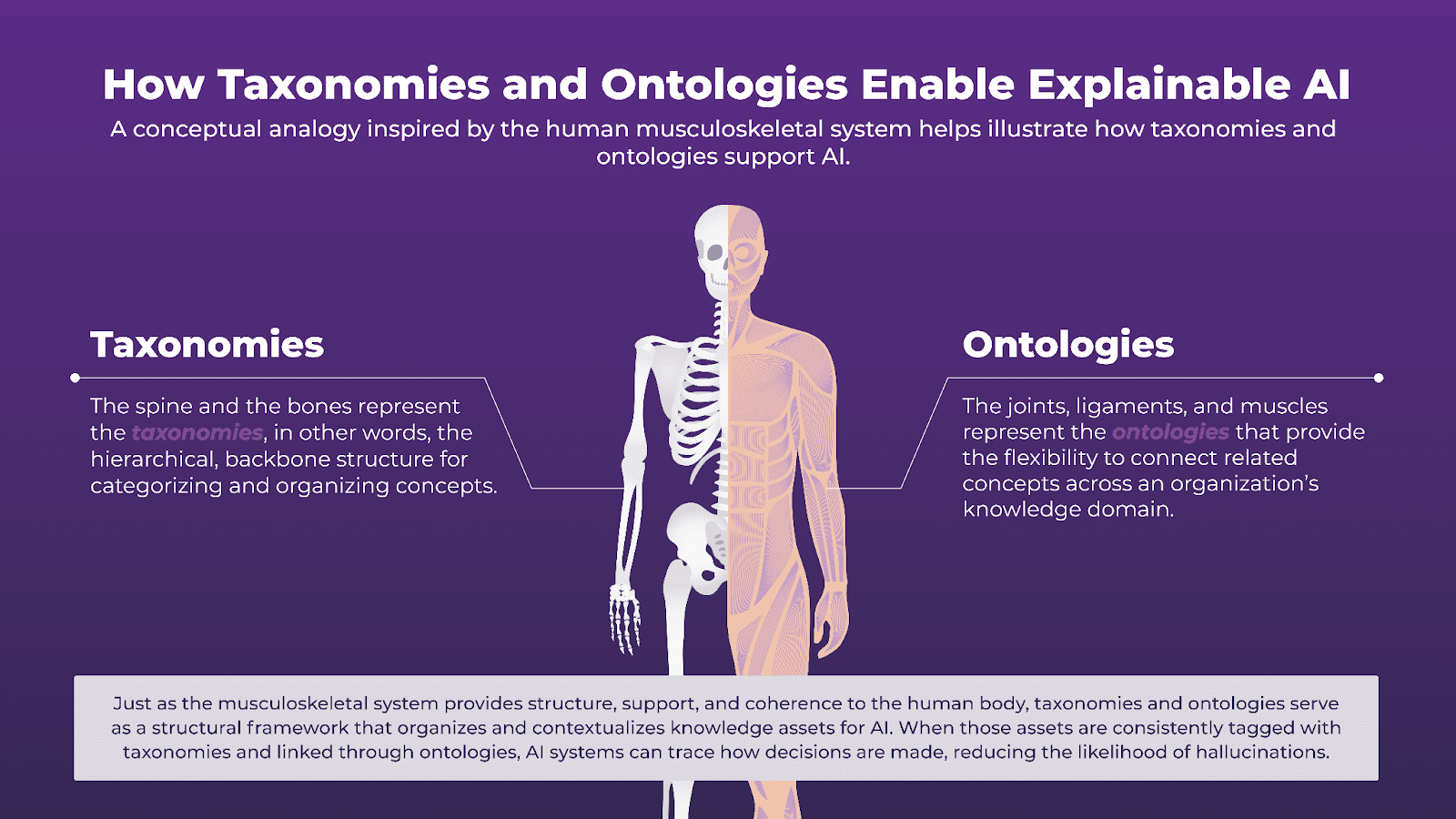Taxonomy and ontology models are essential to unlocking the value of knowledge assets. They provide the structure needed to connect fragmented information across an organization, enabling explainable AI. As part of a broader Knowledge Intelligence (KI) strategy, these models help reduce hallucinations and make AI-generated content more trustworthy. This blog provides an overview of why taxonomies and ontologies are essential to connect disparate knowledge assets within an organization and improve the quality and accuracy of AI generated content.
The Anatomy of AI
Here is a conceptual analogy to help illustrate how taxonomies and ontologies support AI. While inspired by the human musculoskeletal system, this analogy is not intended to represent anatomical accuracy, but rather to illustrate how taxonomies provide foundational structure and ontologies enable flexible, contextual connections of knowledge assets within AI systems.
Just like the musculoskeletal system gives structure, support, and coherence to the human body, taxonomies and ontologies provide the structural framework that organizes and contextualizes knowledge assets for AI. Here is the analogy: the spine and the bones represent the taxonomies, in other words, the hierarchical, backbone structure for categorizing and organizing concepts that describe an organization’s core knowledge assets. Similarly, the joints, ligaments, and muscles represent the ontologies that provide the flexibility to connect related concepts across assets in an organization’s knowledge domain.

Depending on the organization’s domain or industry, certain types of knowledge assets become more relevant or strategically important. In the case of a healthcare organization, key knowledge assets may include content such as patients’ electronic health records, clinical guidelines and protocols, multidisciplinary case reviews, and research publications, as well as data such as diagnostic data and clinical trial data. Taxonomies that capture and group together key concepts, such as illnesses, symptoms, treatments, outcomes, medicines, clinical specialties can be used to tag and structure these assets. Continuing with the same scenario, an ontology in a healthcare organization can incorporate those key concepts (entities) from the taxonomy, along with their properties and relationships, to enable alignment and consistent interpretation of knowledge assets across systems. Both taxonomies and ontologies in healthcare organizations make it possible to connect, for instance, a patient’s health record with diagnostic data and previous case reviews for other patients based on the same (or similar) conditions, including illnesses, symptoms, treatments, and medicines. As a result, healthcare professionals can quickly access the information they need to make well-informed decisions about a patient’s care.
Where AI is Failing
On multiple occasions, AI has repeatedly failed to provide reliable information to employees, customers, and patients, undermining their confidence in the AI supported system and sometimes leading to serious organizational consequences. You may be familiar with the case in which a chatbot of a medical association was unintentionally giving harmful advice to people with eating disorders. Or maybe you heard in the news about the bank with a faulty AI system that misclassified thousands of transactions as fraudulent due to a programming error, resulting in significant customer dissatisfaction and harming the organization’s reputation. There was also a case in which an AI-powered translation system failed to accurately assess asylum seekers’ applications, raising serious concerns about its fairness and accuracy, and potentially affecting critical life decisions for those applicants. In each of these cases, had the corresponding AI systems effectively aggregated both unstructured and structured knowledge assets, and reliably linked them to encoded expert knowledge and relevant business context, these cases would have produced very different and positive outcomes. By leveraging taxonomies and ontologies to aggregate key knowledge assets, the result of these cases would have been much more closely aligned with intended objectives, ultimately, benefiting the end users as it was initially intended.
How Taxonomies And Ontologies Enable Explainable AI
When knowledge assets are consistently tagged with taxonomies and related via ontologies, AI systems can trace how a decision was made. This means that end users can understand the reasoning path, supported by defined relationships. This also means that bias and hallucinations can be more easily detected by auditing the semantic structure behind the results.
As illustrated in the healthcare organization example, diagnoses can be tagged with medical industry taxonomies, while ontologies can help create relationships among symptoms, treatments, and outcomes. This can help physicians tailor treatments to individual patient needs by leveraging past patient cases and the collective expertise from other physicians. Similarly, a retail organization can enhance its customer service by implementing a chatbot that is linked to structured product taxonomies and ontologies to help deliver consistent and explainable answers about products to customers. More consistent and trustworthy customer interactions result in streamlining end user support and strengthening brand confidence.
Do We Really Need Taxonomies and Ontologies to be Successful With AI?
The examples above illustrate that explainability in AI really matters. Whether end users are patients, bank customers, or any individuals requesting specific products or services, they all want more transparent, trustworthy, and human-centered AI experiences. Taxonomies and ontologies help provide structure and connectedness to content, documents, data, expert knowledge and overall business context, so that they all are machine readable and findable by AI systems at the moment of need, ultimately creating meaningful interactions for end users.
Conclusion
Just like bones, joints, ligaments, and muscles in the human body, taxonomies and ontologies provide the essential structure and connection that allow AI systems to stand up to testing, be reliable, and perform with clarity. At EK we have extensive experience identifying key knowledge assets as well as designing and implementing taxonomies and ontologies to successfully support AI initiatives. If you want to improve the Knowledge Intelligence (KI) of your existing or future AI applications and need help with your taxonomy and ontology efforts, don’t hesitate to get in touch with us.
